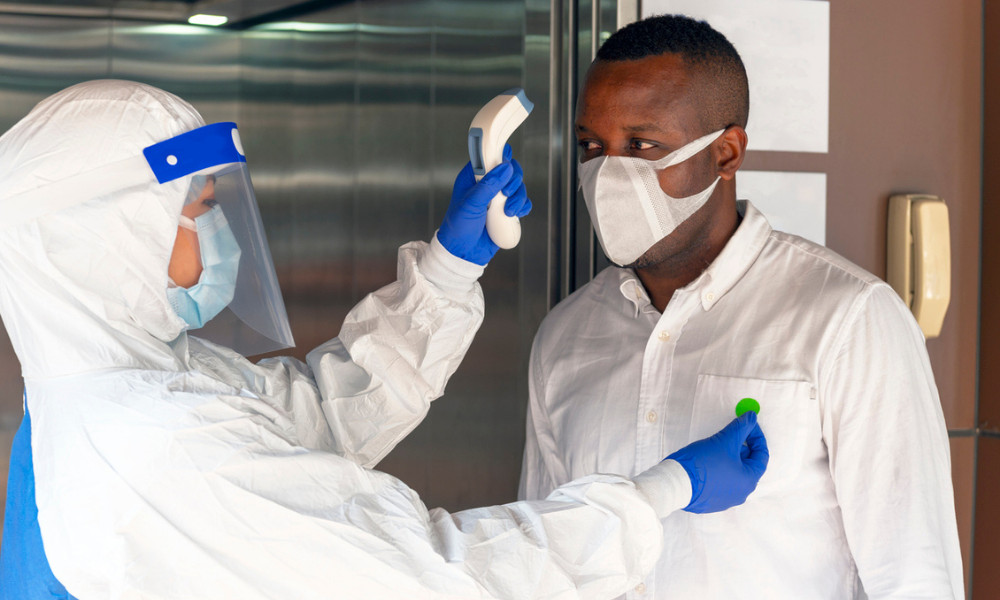'We didn't do enough from a public health point of view to better understand the role the workplace played in transmission'

In looking at COVID-19 outbreaks, workplaces accounted for a much lower rate than the community, according to two recent studies.
Many of the findings were eye-opening, says Peter Smith, scientific codirector and senior scientist at the Institute for Work & Health (IWH), and lead researcher.
“We actually expected that workplaces were going to see much higher rates of transmission in the workplace [and] potentially rates of infection control procedures are going to be much lower,” he says. “But what we ended up finding was that about 85 per cent of people reported they had good infection control procedures in the workplace; often they reported having three or four different types of infection control practices.”
“But information is everything, and so the main thing that we’ve learned is that we really didn’t do enough from a public health point of view to better understand the role the workplace played in the transmission of COVID-19.”
Variation by industry
The studies looked at population-level rates of infections reported by public health units along with surveys conducted by Statistics Canada on infection control measures, with a sample of 53,300 persons queried between July and September 2020.
The numbers seemed to show that workplaces, in most cases, did not represent large outbreaks and were lower than community spread ones, says Smith. Between April 1, 2020 and March 31, 2021, workplaces accounted for 12 per cent of all cases.
“While it was variable across different industry groups, probably about 70 to 75 per cent of workers were actually in industries where the rate of transmission in the workplace was lower than it was in the community for working-age population,” he says.
While some industries did fare more poorly (such as health care, agriculture, food manufacturing and social assistance) than others, most fared well, says Smith.
“Workplaces which were opened were doing a good job around infection control, and a majority actually had rates of COVID that were lower than the community,” he says.
What did work for many workplaces was a laser-quick focus and reaction by some employers, says Smith.
“Workplaces that had good safety recognition procedures and good communication procedures tended to fare better, were able to pivot more quickly and able to disseminate information more rapidly than those that didn’t.”
Forgotten lessons from past pandemics
In the early days of the pandemic, the real story might have represented a failure to learn from our recent past, says Paul Bozek, associate professor at the Dalla Lana School of Public Health at the University of Toronto and past president of the Occupational Hygiene Association of Ontario (OHAO).
“If you look at the [Ontario Judge Archie] Campbell commission report from SARS 1, one of the things that came out was ‘Assume the worst case’ i.e. assume it’s airborne from the beginning, and that’s a lesson that we obviously forgot at the beginning of this pandemic.”
This uncertainty may have contributed greatly to high rates of infection in the health-care sector, he says. And in the agricultural sector, which also experienced a number of outbreaks, the nature of the work is most likely one of the big reasons it was thus afflicted, according to Bozek.
“Whether it was farm labourers who were living together and in congregate work settings or… because they were indoors in a poorly ventilated greenhouse or mushroom farm.”
For outbreaks in the food manufacturing sectors, this represented a “missed opportunity in terms of better understanding how COVID spreads” when public health and Ontario government officials didn’t better study outbreaks, says Smith.
“There’s something about the food manufacturing environment that led to COVID spreading more easily than it did in a non-food-manufacturing workplaces and these might be things around higher rates of liquids in a food manufacturing environment, colder temperatures… but again, here’s a situation where had we gone into a food-manufacturing and non-food-manufacturing workplace early in the pandemic, we could have better understood why it was transmitting in some workplaces but not in others.”
In construction, for instance, the level of disease was low despite there being less protective measures such as physical distancing and PPE being made available, and this could be due to others practices that were done, says Smith.
“We do know that construction companies, a lot of them, were very actively testing workers entering the workplace; but again, that’s another sort of puzzle that we don’t really know.”
For other industries, the infection control measures worked well, he says. “There are other industries where it does line up in terms of the protections that were in place… retail trade, accommodation and food services had very low rates of COVID transmission and also very high rates of PPE provision and physical distancing in place.”
Canadian HR Reporter previously spoke with an expert about how employers should handle employees who refuse to work for health and safety reasons.
Future studies on workplace transmission
Moving forward, other areas that would be ripe for study include the role air flow plays inside buildings spreading illnesses such as COVID, says Bozek.
“As occupational hygienists, we’re the ones that are worried about worker exposures and since we understand now that this is an airborne disease, number one for us is engineering-type controls and that would be ventilation within workplaces.”
This area and others could have been more fervently looked at or mandated, says Bozek, who singled out the Ontario Ministry of Labour’s inaction.
“They weren’t insisting on improved ventilation controls in workplaces, they were just saying, ‘Maintain the kinds of ventilation systems that you have’ and now we see there’s guidance coming out from professional associations, people like ASHRAE, the American Society of Heating, Refrigerating and Air-Conditioning Engineers midway through the pandemic, were saying, ‘You’ve got to increase the amount of outdoor air, you’ve got to increase the filtration and you’ve got to put the portable filtration in if you can,’” he says.
Taking a look at Workplace Safety and Insurance Board (WSIB) COVID-claim data may also yield information that could better inform the future, says Anne-Marie Landis-Groom, president of the board of directors of the OHAO.
“This is all publicly available information… so just do a deeper dive into the case scenario from a workplace perspective, looking at: ‘Was the source identified? What were the activities that the worker was carrying out that put them at a higher risk of exposure?’ Information about the work environment and processes and all of that is really within the wheelhouse of the field of occupational hygiene that could be reviewed.”
In the future, many things such as excessive hand washing and wearing gowns or gloves will probably fade, says Bozek. “With COVID specifically, fomite infection, i.e. transferred to the hands and then you touching your face, your eyes that’s been shown to be a pretty minor contribution to the overall rate of infection.”
As well, mandating temperature checks at certain facilities such as long-term care homes will probably go by the wayside, he says.
“That’s probably overdoing it right now because people could be asymptomatic… [and] the temperature is just an unreliable indicator of you being sick unless you’re at the height of an infection.”
COVID also had an adverse affect on women’s health, found another study.




